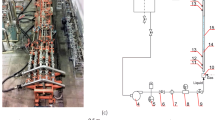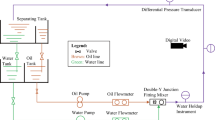Abstract
The water-lubricated transportation of heavy oil seems to be an attractive method for crude oil production with significant savings in pumping power. With oil surrounded by water along the pipe, oil–water core–annular flow forms. In this paper, the characteristics of oil–water core–annular flow in a horizontal acrylic pipe were investigated. Plexiglas pipes (internal diameter = 14 mm and length = 7.5 m) and two types of white oil (viscosity = 0.237 and 0.456 Pa·s) were used. Flow patterns were observed with a high-speed camera and rules of flow pattern transition were discussed. A pressure loss model was modified by changing the friction coefficient formula with empirical value added. Totally 224 groups of experimental data were used to evaluate pressure loss theoretical models. It was found the modified model has been improved significantly in terms of precision compared to the original one. With 87.4% of the data fallen within the deviation of ± 15%, the new model performed best among the five models.
Similar content being viewed by others
Change history
05 February 2022
A Correction to this paper has been published: https://doi.org/10.1007/s42757-022-0132-z
References
Al-Wahaibi, T. 2012. Pressure gradient correlation for oil–water separated flow in horizontal pipes. Exp Therm Fluid Sci, 42: 196–203.
Al-Wahaibi, T., Al-Wahaibi, Y., Al-Ajmi, A., Al-Hajri, R., Yusuf, N., Olawale, A. S., Mohammed, I. A. 2014. Experimental investigation on flow patterns and pressure gradient through two pipe diameters in horizontal oil–water flows. J Petrol Sci Eng, 122: 266–273.
Angeli, P., Hewitt, G. F. 1999. Pressure gradient in horizontal liquid–liquid flows. Int J Multiphase Flow, 24: 1183–1203.
Arney, M. S., Bai, R., Guevara, E., Joseph, D. D., Liu, K. 1993. Friction factor and holdup studies for lubricated pipelining—I. Experiments and correlations. Int J Multiphase Flow, 19: 1061–1076.
Bai, R. Y., Chen, K. P., Joseph, D. D. 1992. Lubricated pipelining: Stability of core–annular flow. Part 5. Experiments and comparison with theory. J Fluid Mech, 240: 97–132.
Bannwart, A. C. 1999. A simple model for pressure drop in horizontal core annular flow. J Braz Soc Mech Sci, 21: 233–244.
Bannwart, A. C. 2001. Modeling aspects of oil–water core–annular flows. J Petrol Sci Eng, 32: 127–143.
Bannwart, A. C., Rodriguez, O. M. H., de Carvalho, C. H. M., Wang, I. S., Vara, R. M. O. 2004. Flow patterns in heavy crude oil–water flow. J Energ Resour Technol, 126: 184–189.
Bensakhria, A., Peysson, Y., Antonini, G. 2004. Experimental study of the pipeline lubrication for heavy oil transport. Oil Gas Sci Technol, 59: 523–533.
Brauner, N. 1991. Two-phase liquid–liquid annular flow. Int J Multiphase Flow, 17: 59–76.
Brauner, N. 1998. 2.3.5 Multiphase fluid flow and pressure drop: Liquid–liquid two-phase flow. Heat Exchanger Design Updates, 5.
Brauner, N., Moalem Maron, D. 1992. Stability analysis of stratfied liquid–liquid flow. Int J Multiphase Flow, 18: 103–121.
Brauner, N., Moalem Maron, D. 1999. Classification of liquid–liquid two-phase flow systems and the prediction of flow pattern maps. In: Proceedings of the 2nd International Symposium on Two-Phase Flow Modeling and Experimentation, 9: 747–754.
Charles, M. E., Govier, G. W., Hodgson, G. W. 1961. The horizontal pipeline flow of equal density oil–water mixtures. Can J Chem Eng, 39: 27–36.
Chen, N. H. 1979. An explicit equation for friction factor in pipe. Ind Eng Chem Fundamen, 18: 296–297.
Georgiou, E., Maldarelli, C., Papageorgiou, D. T., Rumschitzki, D. S. 1992. An asymptotic theory for the linear stability of a core–annular flow in the thin annular limit. J Fluid Mech, 243: 653–677.
Ghosh, S., Mandal, T. K., Das, G., Das, P. K. 2009. Review of oil water core annular flow. Renew Sust Energ Rev, 13: 1957–1965.
Grassi, B., Strazza, D., Poesio, P. 2008. Experimental validation of theoretical models in two-phase high-viscosity ratio liquid–liquid flows in horizontal and slightly inclined pipes. Int J Multiphase Flow, 34: 950–965.
Isaac, J. D., Speed, J. B. 1904. Method of piping fluids. U.S. Patent 759,374.
Jain, A. K. 1976. Accurate explicit equation for friction factor. J Hydr Eng Div, 102: 674–677.
Joseph, D. D., Bai, R. Y., Mata, C., Sury, K., Grant, C. H. R. I. S. 1999. Self-lubricated transport of bitumen froth. J Fluid Mech, 386: 127–148.
Joseph, D. D., Renardy, M., Renardy, Y. 1984. Instability of the flow of two immiscible liquids with different viscosities in a pipe. J Fluid Mech, 141: 309–317.
Lanier, D. 1998. Heavy oil: A major energy source for the 21st century. In: Proceedings of the 7th UNITAR International Conference on Heavy Crude and Tar Sands, 1: 361.
Li, H. W., Wong, T. N., Skote, M., Duan, F. 2013. A simple model for predicting the pressure drop and film thickness of non-Newtonian annular flows in horizontal pipes. Chem Eng Sci, 102: 121–128.
Marinescu, I. D., Rowe, W. B., Dimitrov, B., Ohmori, H. 2012. Tribology of Abrasive Machining Processes. William Andrew.
Martínez-Palou, R., de Lourdes Mosqueira, M., Zapata-Rendón, B., Mar-Juárez, E., Bernal-Huicochea, C., de la Cruz Clavel-López, J., Aburto, J. 2011. Transportation of heavy and extra-heavy crude oil by pipeline: A review. J Petrol Sci Eng, 75: 274–282.
McKibben, M. J., Gillies, R. G., Shook, C. A. 2000. Predicting pressure gradients in heavy oil–water pipelines. Can J Chem Eng, 78: 752–756.
Moody, L. F. 1947. An approximate formula for pipe friction factors. Trans ASME, 69: 1005–1011.
Oliemans, R. V. A., Ooms, G., Wu, H. L., Duijvestijn, A. 1987. Core–annular oil/water flow: The turbulent-lubricating-film model and measurements in a 5 cm pipe loop. Int J Multiphase Flow, 13: 23–31.
Oliemans, R., Ooms, G., Wu, H., Duijvestijn, A. 1985. Core–annular oil/water flow: The turbulent-lubricating-film model and measurements in a 2-in pipe loop. In: Proceedings of the Middle East Oil Technical Conference and Exhibition, SPE-13725-MS.
Ooms, G., Segal, A., van der Wees, A. J., Meerhoff, R., Oliemans, R. V. A. 1983. A theoretical model for core–annular flow of a very viscous oil core and a water annulus through a horizontal pipe. Int J Multiphase Flow, 10: 41–60.
Prada, J. W. V., Bannwart, A. C. 2001. Modeling of vertical core-annular flows and application to heavy oil production. J Energ Resour Technol, 123: 194–199.
Rodriguez, O. M. H., Bannwart, A. C. 2008. Stability analysis of core-annular flow and neutral stability wave number. AIChE J, 54: 20–31.
Rodriguez, O. M. H., Bannwart, A. C., de Carvalho, C. H. M. 2009. Pressure loss in core–annular flow: Modeling, experimental investigation and full-scale experiments. J Petrol Sci Eng, 65: 67–75.
Russell, T. W. F., Charles, M. E. 1959. The effect of the less viscous liquid in the laminar flow of two immiscible liquids. Can J Chem Eng, 37: 18–24.
Saniere, A., Hénaut, I., Argillier, J. F. 2004. Pipeline transportation of heavy oils, a strategic, economic and technological challenge. Oil Gas Sci Technol, 59: 455–466.
Schorle, B. J., Churchill, S. W., Shacham, M. 1980. Comments on: “An explicit equation for friction factor in pipe”. Ind Eng Chem Fundamen, 19: 228.
Serghides, T. 1984. Estimate friction factor accurately. Chem Eng, 91: 63–64.
Shi, J. 2015. A study on high-viscosity oil–water two-phase flow in horizontal pipes. Ph.D. Thesis. Cranfield University.
Shi, J., Yeung, H. 2017. Characterization of liquid–liquid flows in horizontal pipes. AIChE J, 63: 1132–1143.
Singh, V., Lo, S. 2010. Predicting pressure drop in pneumatic conveying using the discrete element modelling approach. Prog Comput Fluid Dy, 10: 334.
Sotgia, G., Tartarini, P., Stalio, E. 2008. Experimental analysis of flow regimes and pressure drop reduction in oil–water mixtures. Int J Multiphase Flow, 34: 1161–1174.
Strazza, D., Grassi, B., Demori, M., Ferrari, V., Poesio, P. 2011. Core–annular flow in horizontal and slightly inclined pipes: Existence, pressure drops, and hold-up. Chem Eng Sci, 66: 2853–2863.
Tan, J. T., Jing, J. Q., Hu, H. L., You, X. Y. 2018. Experimental study of the factors affecting the flow pattern transition in horizontal oil–water flow. Exp Therm Fluid Sci, 98: 534–545.
Tripathi, S., Bhattacharya, A., Singh, R., Tabor, R. F. 2015. Lubricated transport of highly viscous non-Newtonian fluid as core-annular flow: A CFD study. Procedia IUTAM, 15: 278–285.
Zigrang, D. J., Sylvester, N. D. 1982. Explicit approximations to the solution of Colebrook’s friction factor equation. AIChE J, 28: 514–515.
Acknowledgements
This work was supported by the National Natural Science Foundation of China (Grant Nos. 51779212 and 51911530129), Sichuan Science and Technology Program (Grant No. 2019YJ0350), China Postdoctoral Science Foundation funded project (Grant No. 2019M653483), and State Key Laboratory of Heavy Oil Processing (Grant No. SKLOP201901002).
Author information
Authors and Affiliations
Corresponding authors
Rights and permissions
About this article
Cite this article
Hu, H., Jing, J., Tan, J. et al. Flow patterns and pressure gradient correlation for oil–water core–annular flow in horizontal pipes. Exp. Comput. Multiph. Flow 2, 99–108 (2020). https://doi.org/10.1007/s42757-019-0041-y
Received:
Revised:
Accepted:
Published:
Issue Date:
DOI: https://doi.org/10.1007/s42757-019-0041-y




